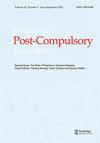支持学徒在瑞士初级职业教育和培训中融入学校和工作场所的学习
IF 0.9
Q3 EDUCATION & EDUCATIONAL RESEARCH
引用次数: 3
摘要
摘要在双初始职业教育和培训(IVET)系统中,学校和工作学习的结合对于为学徒提供必要的特定行业技能和确保培训质量至关重要。然而,学徒们经常感觉到学习地点之间的脱节。因此,基于边界跨越和学校与工作场所连通性的概念,本研究旨在从学徒、职业教师和公司培训师的角度调查学校和工作学习之间的融合如何有助于瑞士IVET的质量。通过焦点小组(n=64)收集数据,并按照归纳和演绎的方法进行主题数据分析。主要调查结果表明,一些问题与学校和培训公司之间的社会文化差异有关:学校学习普遍贬值(与工作场所学习不一致或被视为无用)以及学徒在培训公司的经历多样性。此外,分析揭示了这些被视为脱节的情况如何成为学习机会:通过在工作场所应用在学校获得的非常规技能(转变的学习机制);通过在课堂上引入学徒在工作中所经历的真实情况(反思的学习机制)。讨论了对培训和教学的影响。本文章由计算机程序翻译,如有差异,请以英文原文为准。
Supporting Apprentices’ Integration of School- and Workplace-Based Learning in Swiss Initial Vocational Education and Training
ABSTRACT In a dual initial vocational education and training (IVET) system, an integration between school- and work-based learning is essential to provide apprentices with necessary trade-specific skills and to ensure the quality of training. However, apprentices often perceive a disconnection between learning sites. Accordingly, based on the concepts of boundary crossing and school-workplace connectivity, this study aimed to investigate how the integration between school- and work-based learning contributed to the quality of Swiss IVET from the perspective of apprentices, vocational teachers and in-company trainers. Data were collected through focus groups (n = 64) and thematic data analysis was carried out following an inductive and deductive approach. Key findings indicated some issues related to sociocultural differences between school and training company: a general devaluation of school-based learning (non-aligned with workplace-learning or perceived as useless) and the diversity of apprentices’ experiences at the training company. Furthermore, the analysis revealed how these situations perceived as disconnected can become learning opportunities: by applying a skill acquired at school in the workplace that is not part of the routine (learning mechanism of transformation); by bringing in the classroom authentic situations experienced by apprentices at work (learning mechanism of reflection). Implications for training and teaching are addressed.
求助全文
通过发布文献求助,成功后即可免费获取论文全文。
去求助
来源期刊

Research in Post-Compulsory Education
EDUCATION & EDUCATIONAL RESEARCH-
CiteScore
1.30
自引率
14.30%
发文量
31
期刊介绍:
Throughout the world, there is a growing awareness of the significance of vocational and post-compulsory education and training systems. The majority of countries are working hard to develop their provision, recognising the importance of post-compulsory education in providing educated and skilled people in sufficient numbers at appropriate levels to assist economic and social development. Research in Post-Compulsory Education, sponsored by the United Kingdom"s Further Education Research Association (FERA), recognises the need for more international research and analysis and the generation of relevant theory in order to identify policy needs and trends as well as priorities in this growing area.
 求助内容:
求助内容: 应助结果提醒方式:
应助结果提醒方式:


